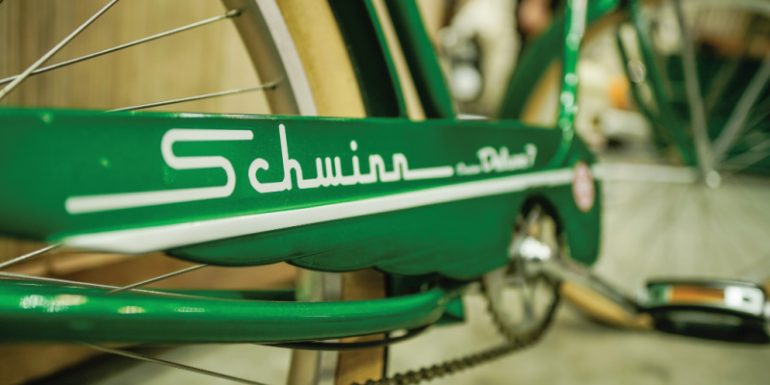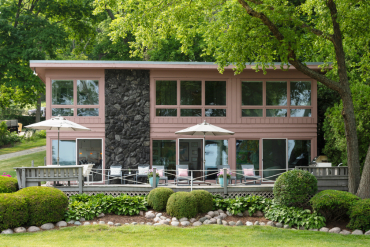By Anne Morrissy
Schwinn: It is a name that is instantly recognizable, immediately conjuring memories of beloved childhood bicycles for millions of Americans. On Geneva Lake, the name is also indelibly connected with a large piece of property on the north shore just east of Cedar Point, where the Schwinn family summered for nearly 70 years in a red-brick mansion constructed in the 1920s. Though the original house was demolished in the 1990s and replaced with a graceful French country-style home, the current owners say that people still frequently ask them if they live on “the Schwinn property.” “We don’t mind,” laughs homeowner Georgia Athans. “It’s such a famous name. But we do wonder how many years we’ll have to live here until they call it the Athans’ property.”
In fact, they almost purchased a different Lake Geneva home with connections to a famous name. When the Athanses were looking to buy on Geneva Lake in the 1990s, they went under contract several times on Casa del Sueño, the Spanish Colonial- style home that was owned for many years by Chicago TV personality Lee Phillip Bell and her producer husband Bill Bell. However, the deal for the historic home repeatedly fell through, and ultimately, the Athanses decided to look for a property where they could build a new home. “The Schwinn property was very lovely. It was one of the bigger pieces of property available at the time, and we have over 300 feet of lake frontage,” Athans explains. “It’s just a beautiful view, and we have quite a bit of space on either side of the house.”
Demolishing the original Schwinn house turned out to be a bigger challenge than they anticipated, however. “The house was solid brick,” Athans says. “And behind the brick were concrete walls. I don’t want to exaggerate here — they had to be at least 12 inches thick!” But then, Schwinn bicycles always were known for their quality and durability.
THE WORLD’S FINEST BICYCLES, QUALITY GUARANTEED
Most people today know that Schwinn bicycles were the biggest sellers of the mid-century, but in fact the company’s history goes back much further than that. Company founder Ignaz Schwinn was born in Germany in 1860 and worked in the fledgling bicycle industry there before coming to America in 1891. Four years later, Schwinn, along with partner Adolph Arnold, formed Arnold, Schwinn and Company in Chicago, to capitalize on the cycling craze that was sweeping the country at that time. In the beginning, the company’s competition was steep — in the late 1800s, America boasted around 300 bicycle manufacturers, two-thirds of which had factories within 150 miles of Chicago. But Schwinn built his company’s reputation on superior design and quality, manufacturing some of the best racing bikes available at the time, as well as sturdy, everyday bikes for a variety of needs. In 1908, Schwinn bought Arnold’s interest, becoming sole owner of the company.
By the early 20th century, the automobile began stealing business away from the bicycle manufacturers, so in 1911 Schwinn diversified his company. First he acquired the Excelsior motorcycle company and then the Henderson motorcycle company, and then he built an almost 300,000-square- foot factory to produce motorcycles. With the addition of Excelsior and Henderson, Schwinn became the third- largest motorcycle manufacturer in the world for a time, behind only Harley- Davidson and Indian motorcycles.
Schwinn’s great-grandson, Richard Schwinn, owner of Waterford Precision Cycles, says it was the motorcycle arm of the Schwinn business that provided the funds for Ignaz and his wife Helen to build a summer home on Geneva Lake in the 1920s. “My great-grandfather was at the heyday of his commercial life at that time,” he explains. “And the really successful business [in the 1920s] was his motorcycle business.”
The stock market crash in 1929 and the Great Depression of the 1930s took a toll on Schwinn. The company ceased production of motorcycles in 1931 but continued to innovate its bicycle business. Then under the leadership of Ignaz Schwinn’s son Frank W. (F.W.) Schwinn, the Schwinn company extended its reputation as a leader in bicycle design, technology and manufacturing. During WWII, Schwinn made 10,000 bicycles per year for the U.S. military as part of the company’s extensive defense contracts — they also produced military casings and other supplies for the U.S. Navy and Army in their factory, eventually earning them recognition for excellence in wartime manufacturing.
Ignaz Schwinn died in 1948 at the age of 88, but under F.W.’s leadership, the company was about to get a huge lift thanks to the post-war baby boom. In 1950, one in every four bicycles sold in America was a Schwinn. Through aggressive advertising and an innovative authorized dealership arrangement, Schwinn bicycles only rose in popularity from that moment forward, becoming a status symbol among America’s youth and a ubiquitous sight in mid-century America. From the 1950s through the late 1970s, Schwinn dominated the bicycle sales market in the United States. In 1974, at the peak of their success, Schwinn sold more than 1.5 million bicycles in a single year. Today, Pacific Cycle, an American division of Canadian conglomerate Doral Industries, owns the Schwinn brand.
CONSTRUCTING A SOLID SUMMER GETAWAY
According to Richard Schwinn, his grandfather F.W. Schwinn was the first Schwinn to fall in love with Geneva Lake. Not long after marrying his wife Gertrude in 1918, F.W. bought a home in Congress Club on Williams Bay. Shortly after that in 1921, F.W.’s parents, Ignaz and Helen, purchased four acres of land adjacent to the still-undeveloped Cedar Point Park subdivision and hired an architect to build a house overlooking the lake.
Ignaz Schwinn was extremely concerned about fire; as a result, he tasked the architect with designing a home that was nearly fire-proof by 1920s standards. “The story goes that my great-grandfather instructed the architect that he wanted to be able to pour 1,500 gallons of fuel oil into the basement and set it on fire and still have at least two-and- a-half hours for everyone to get out of the house safely,” Richard Schwinn explains. Athans points out that Ignaz Schwinn was perhaps wise to be concerned about fire – many lake homes burned in the first few decades of the 20th century.
To achieve the fire-proofing, the architect’s plans called for technology more commonly found in skyscrapers of the era, including a steel-beam structure and thick concrete walls. He designed the exterior of the six-bedroom, six- bathroom house in a loosely Victorian style with a central tower and widow’s walk, boxy in shape and finished in red brick. “It was kind of a German design, understated by mansion standards,” Richard Schwinn describes. A matching boathouse at the waterfront, a six-car garage, a greenhouse and a caretaker’s cottage completed the property. Inside, the Schwinns filled the home with Persian rugs, English walnut chairs and a Chickering grand player piano. Richard Schwinn believes his great-grandparents moved into the home around 1926.
Following Ignaz Schwinn’s death in 1948, F.W. and Gertrude moved into the house. F.W. was an avid fisherman. In the summers, he would live at the family’s Humboldt Park home in Chicago and go to work at the factory during the week, and then hurry to catch the train to Lake Geneva on Friday afternoons for a weekend of fishing and relaxation. As they got older, F.W.’s wife Gertrude had difficulty walking the steep path from the house to the pier, so F.W. installed an innovative tram on a track that could transport them to and from the lake. Because the tram tracks crossed the public lakeshore path, it became a memorable part of the property, remaining in place until the Athanses purchased the land decades later.
A CHATEAU RISING FROM THE RUBBLE
The home stayed in the Schwinn family until the 1990s. According to Athans, by the time the family put it up for sale, the house was extremely dated and showed heavy signs of wear and tear. Athans and her husband loved the property but had a different vision for their dream home. The first step was to demolish the old brick mansion, which was no small task. Athans remembers the crew they hired hauling away endless loads of brick and concrete. “It was a challenging house to tear down,” she says.
Next, they hired Lake Geneva architects McCormack + Etten to design their new home. “We wanted a French-style house,” Athans explains. “I just love French things. I like French designers, French clothes, French everything … it’s just something I gravitate to.” The home the architects and the Athanses designed echoes the famous chateaus of the French countryside. “We also moved the footprint of the house a little further from the lake, to get the best view,” she explains. “It’s just a beautiful piece of property and now the house is high enough that we can see across the lake, all the way to Black Point. We love it because we live on enough property to feel private but without feeling secluded.”
They moved into the new home in 1997. Athans says she chose the finishing touches to suit the home’s inspiration: painted French country furniture beside dark-wood tables, French doors with curved and beveled glass, a chandelier meant to mimic gaslight. “I was going for an overall look that was French, but not so formal,” she explains. They chose to keep the original boathouse Ignaz Schwinn had built in the 1920s, maintaining a connection with the home’s previous owners, but updated the interior to use as guest quarters and matched the exterior finishes to those of the new house.
Today the Athanses enjoy hosting the families of their two children — including five grandchildren — in the home. Reflecting on the property’s history, Athans marvels: “We all had Schwinn bicycles when the kids were growing up — myself, my husband, my daughter … and I think my son had every Schwinn bicycle that ever came out. Who would have guessed back then that we’d be living on the Schwinn property someday?”





